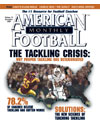AMERICAN FOOTBALL MONTHLY THE #1 RESOURCE FOR FOOTBALL COACHES
Article CategoriesAFM Magazine
|
The Off-Season: Preparing for Advanced Level Training (Part II)by: Dale BaskettFootball Speed Specialist © More from this issue This is part II in Dale Baskett’s column on eight elements of speed training in the off-season. In part I, Dale presented four of the eight elements starting with periodization, foundation principles, load work and assisted speed training (to read last month’s column, please visit www.AmericanFootballMonthly.com). This month Dale discusses elements five through eight. 5. Tighten Your Focus Be specific when deciding what’s important for football speed. Specificity of football activity has many complexities when physical athletic movement is required. Football requires that an athlete move without altering velocity as movement changes are presented. Design your training to address these needs for each pos....The full article can only be seen by subscribers. Subscribe today!
|
|
|||||||
| HOME |
MAGAZINE |
SUBSCRIBE | ONLINE COLUMNISTS | COACHING VIDEOS |
Copyright 2025, AmericanFootballMonthly.com
All Rights Reserved





